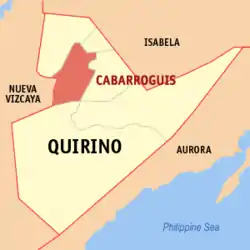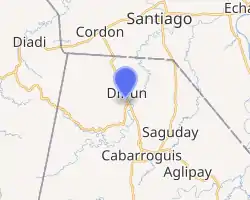Cabarroguis
Cabarroguis, officially the Municipality of Cabarroguis (Ilocano: Ili ti Cabarroguis; Tagalog: Bayan ng Cabarroguis), is a 3rd class municipality and capital of the province of Quirino, Philippines. According to the 2015 census, it has a population of 30,582 people. [3]
Cabarroguis | |
|---|---|
| Municipality of Cabarroguis | |
 Cabarroguis Town Hall | |
 Seal | |
 Map of Quirino with Cabarroguis highlighted | |
OpenStreetMap 
| |
.svg.png.webp) Cabarroguis Location within the Philippines | |
| Coordinates: 16°35′00″N 121°30′00″E | |
| Country | |
| Region | Cagayan Valley (Region II) |
| Province | Quirino |
| District | Lone District |
| Barangays | 17 (see Barangays) |
| Government | |
| • Type | Sangguniang Bayan |
| • Mayor | Willard V. Abuan |
| • Vice Mayor | Narciso C. Kitan |
| • Representative | Junie E. Cua |
| • Electorate | 19,979 voters (2019) |
| Area | |
| • Total | 260.20 km2 (100.46 sq mi) |
| Elevation | 162 m (531 ft) |
| Population | |
| • Total | 30,582 |
| • Density | 120/km2 (300/sq mi) |
| • Households | 6,822 |
| Economy | |
| • Income class | 3rd municipal income class |
| • Poverty incidence | 10.81% (2015)[4] |
| • Revenue | ₱134,660,080.64 (2016) |
| Time zone | UTC+8 (PST) |
| ZIP code | 3400 |
| PSGC | |
| IDD : area code | +63 (0)78 |
| Climate type | tropical rainforest climate |
| Native languages | Ilocano Ilongot Tagalog |
| Website | www |
History
Prior to the advent of settlement, Cabarroguis is a vast forested area and form parts of the municipalities of Saguday, Diffun and Aglipay. It is originally occupied by the Aetas and later displaced by the Ilongot tribe because the Aetas are known of their nomadic characters. Many years later, permanent settlement were made by different civilized ethnic groups like Ilocanos, Tagalog and others in search of good fortune in this virgin land. As the population and settlement increases, regular barrios were created. These are the barrios of Zamora, Banuar, Burgos, Del Pilar, Dibibi, Eden, Villamor and five (5) more sitios of Villapeña, Villarose, Tucod, Calaocan and Dingasan at the municipality of Aglipay: barrios of San Marcos, Gundaway and portion of Mangandingay at the municipality of Diffun and the other part of Mangandingay at the municipality of Saguday. The above stated barrios of different municipalities became the territorial jurisdiction of Cabarroguis by virtue of Republic Act No. 5554 enacted by the Philippine Congress authored by then Honorable Senator Leonardo Perez on June 21, 1969. The newly created municipality of Cabarroguis was named in honor of the late Congressman of Nueva Vizcaya, Honorable Leon Cabarroguis.
Cabarroguis operated as a regular municipality after the 1971 local polls wherein Honorable Anastacio dela Pena become the first Local Chief Executive. Barangay Mangandingay also became the temporary seat of the municipal government, Years later, when Honorable Diomedes Dumayas was appointed as the town’s executive, the seat of the Local Government officially transferred to Barangay Zamora where a 12 hectares lot was donated.
Vision and Mission Statement
After a lengthy discussion and deliberation of the Executive and Legislative department together with the planning team we come up with the Mission and Vision statement that encompasses all our development aspirations
“CABARROGUIS AS CENTER OF TECHNOLOGICAL INNOVATIONS WITH VALUE ORIENTED AND RESILIENT SOCIETY LIVING IN AN ECOLOGICALLY BALANCED ECONOMY”
Our vision is translated into our mission statement that will serve as our benchmark of coming with our sectoral goals aligned with the priority thrust of our current administrations
To promote the standard of living through vibrant technological innovations in education, agriculture and ecology, health care , commerce and industry carried out through participative legislation and governance
Geography
Cabarroguis is located in the northwestern part of the province of Quirino. It is bounded on the north, northwest and northeast by the municipalities of Diffun and Saguday respectively, on the east and southeast by the municipality of Aglipay, on the south by the municipalities of Maddela and Nagtipunan, and on the west by the province of Nueva Vizcaya. It is about 12 kilometres (7.5 mi) from the provincial boundary between Province of Quirino and Isabela at barangay San Antonio, Diffun, Quirino.
The municipal area of Cabarroguis covers 26,902 hectares approximately. The area is further distributed into the seventeen (17) barangays comprising the municipality including barangay Didipio which remains to be in the municipality and the province of Nueva Vizcaya and Quirino.
Barangays
Cabarroguis is politically subdivided into 17 barangays.
| Barangay | Land Area (has.) |
|---|---|
| Urban: | |
| Gundaway | 629.6612 |
| Zamora | 427.1250 |
| Mangandingay | 500.7266 |
| San Marcos | 667.7311 |
| Sub-total: | 2,255.2439 |
| Rural: | |
| Villarose | 843.1654 |
| Banuar | 546.6502 |
| Villamor | 865.3353 |
| Del Pilar | 550.1530 |
| Villapeña | 642.1622 |
| Burgos | 1,288.4090 |
| Eden | 1,001.8760 |
| Gomez | 491.8008 |
| Dingasan | 3,108.0650 |
| Calaocan | 677.9979 |
| Dibibi | 3,491.2367 |
| Sto. Domingo | 299.6062 |
| Tucod (including Didipio) | 10,869.8230 |
| Sub-total: | 24,646.7561 |
| Total: | 26,902 |
Demographics
Initially, year 1970 recorded a population of 7,835 person followed by census year 1975 which registered a total population of 12,226 that manifested a growth rate of 9.29%. Another increase of population was observed during census year 1980 which recorded 17,450 displaying a growth rate of 2.2% and for census year 1995, it manifested a 22,812 person displaying a growth rate of 2.25%. Base year of 2000 recorded a total population of 25,832 which manifested a growth rate of 2.25%. As of census year 2007, the population increased to 28,024 which manifested a growth rate of 1.21%.
|
| |||||||||||||||||||||||||||||||||
| Source: Philippine Statistics Authority [3] [5] [6][7] | ||||||||||||||||||||||||||||||||||
References
- Municipality of Cabarroguis | (DILG)
- "Province: Quirino". PSGC Interactive. Quezon City, Philippines: Philippine Statistics Authority. Retrieved 12 November 2016.
- Census of Population (2015). "Region II (Cagayan Valley)". Total Population by Province, City, Municipality and Barangay. PSA. Retrieved 20 June 2016.
- "PSA releases the 2015 Municipal and City Level Poverty Estimates". Quezon City, Philippines. Retrieved 12 October 2019.
- Census of Population and Housing (2010). "Region II (Cagayan Valley)". Total Population by Province, City, Municipality and Barangay. NSO. Retrieved 29 June 2016.
- Censuses of Population (1903–2007). "Region II (Cagayan Valley)". Table 1. Population Enumerated in Various Censuses by Province/Highly Urbanized City: 1903 to 2007. NSO.
- "Province of Quirino". Municipality Population Data. Local Water Utilities Administration Research Division. Retrieved 17 December 2016.
External links
| Wikimedia Commons has media related to Cabarroguis, Quirino. |
